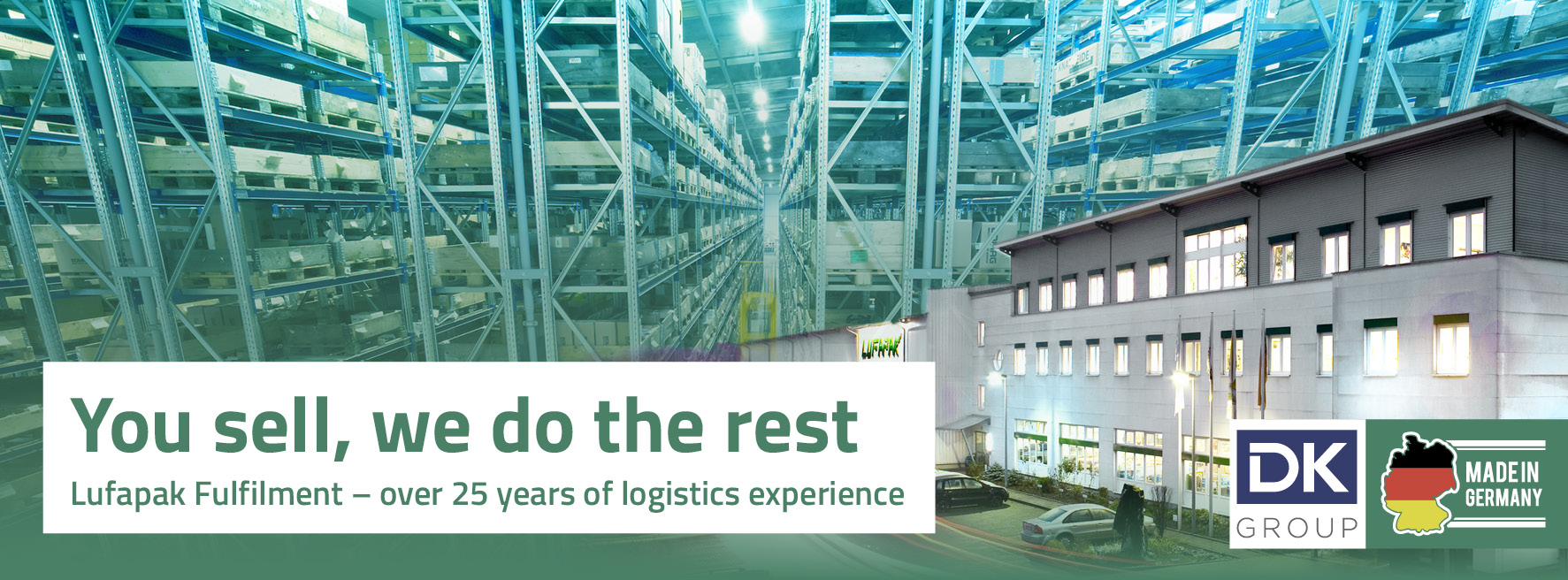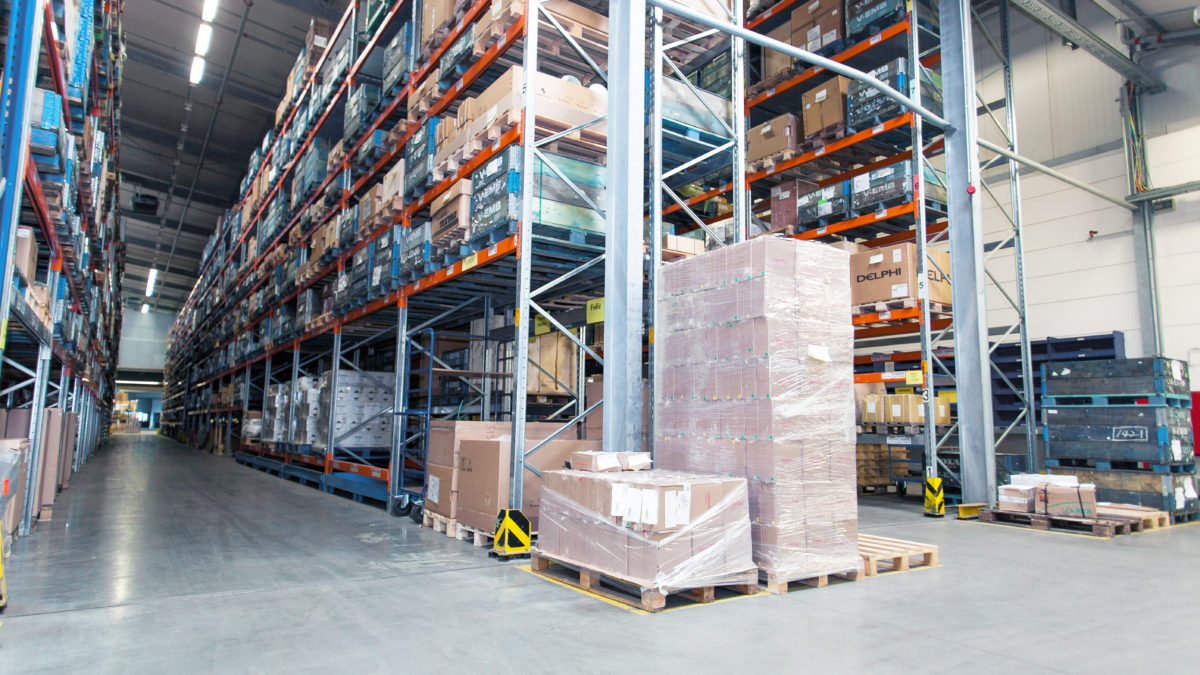sales@lufapak.de +49 2631/384-0 Contactform
Introduction to the world of high-bay warehouses
In the modern world of e-commerce and global supply chains, efficient warehousing is crucial to a company’s success. This is where high-bay warehouses come into play. High-bay warehouses are specialized storage systems that are designed to make optimal use of the available space by building upwards rather than outwards.
A high-bay warehouse, as the name suggests, is a warehouse that consists of tall racking systems that are often several meters high. These racks can be operated manually with forklift trucks or automatically with special stacker cranes. The main advantages of high-bay warehouses are their high storage density, their efficiency and their ability to store a large number of items in a small space.
Below we will take a closer look at the different types of high-bay warehouses, their benefits and how they are revolutionizing warehouse management.
What is a high-bay warehouse?
A high-bay warehouse is a special type of warehouse that is characterized by its height. In contrast to conventional warehouses, which usually have a height of around 3 to 7 meters, high-bay warehouses can be up to 50 meters high. This height makes it possible to store a significantly larger number of goods on the same area of land and therefore use the space more efficiently.
In a high-bay warehouse, goods are stored on pallets stacked in high racks. The racks are designed so that they can be operated by special devices known as storage and retrieval machines (SRMs). These devices can be controlled automatically or manually and are able to raise and lower the pallets to the desired height.

Differences between high-bay warehouses and conventional warehouses
While traditional warehouses rely on horizontal space and often have limited height, high bay warehouses utilize vertical space to store more goods. This results in a higher storage density and can help to reduce land and building costs.
Another difference lies in the way the goods are handled. In a traditional warehouse, workers may have to physically interact with the goods, moving and sorting them. In a high-bay warehouse, on the other hand, goods are usually handled by automated systems or specialized machines, making the process more efficient and less prone to errors.
In addition, high-bay warehouses can often be better tailored to a company’s specific needs. For example, they can be designed to better handle certain types of goods, such as heavy or bulky items. They can also be equipped with modern technologies such as automated warehouse management and real-time inventory tracking to further increase efficiency.
The automated high-bay warehouse
An automated high-bay warehouse is a warehouse that is equipped with automated systems to facilitate the storage and handling of goods. This system uses a combination of mechanics and computer technology to control the movement of goods in the warehouse.
How an automated high-bay warehouse works
In an automated high-bay warehouse, goods are stored on pallets stacked on high shelves. Instead of people, special machines, known as storage and retrieval machines (SRMs), operate the racks. These devices are computer-controlled and can transport the pallets precisely to the desired location.
The stacker cranes are equipped with sensors that enable them to precisely determine their position in the warehouse and the exact location of each pallet. They are also able to lift the pallets to the correct height and then transport them safely and efficiently to their destination.
Advantages of an automated high-bay warehouse
There are many advantages that an automated high-bay warehouse offers. Some of them are:
- Efficiency: because the SRMs are computerized, they can perform tasks faster and more accurately than humans. This can help to increase productivity and reduce operating costs.
- Accuracy: The stacker cranes can determine the exact location of each pallet in the warehouse, which helps to minimize errors and improve the accuracy of warehouse management.
- Safety: As the SRMs handle the goods, the risk of workplace accidents is reduced.
Possible disadvantages of an automated high-bay warehouse
Despite the many advantages, there are also some potential disadvantages associated with an automated high-bay warehouse:
- High initial investment: Setting up an automated high bay warehouse can be expensive as it requires specialized equipment and software.
- Technical issues: As with any technology, technical problems can occur with automated high bay warehouses. This can lead to downtime and affect the efficiency of the warehouse.
- Maintenance: Automated high-bay warehouses require regular maintenance to ensure that they function properly. This can result in additional costs.
Pallet high-bay warehouse
A pallet high-bay warehouse is a specific type of warehouse that is specially designed for storing goods on pallets. These storage systems consist of high racks that have been specially designed to store pallets at different heights and thus make optimum use of the available space.
How does a pallet high-bay warehouse work?
In a high-bay pallet warehouse, goods are stored on pallets and then stored in the racks with the help of forklift trucks or special storage and retrieval machines. The racks are designed to hold several pallets on top of each other, making efficient use of the vertical space in the warehouse.
The pallets can then be removed from the racking as required and transported to another location for further use or shipping.
Advantages of a high-bay pallet warehouse
Some of the main advantages of a pallet high-bay warehouse are
- Space optimization: by using vertical space, more goods can be stored in a pallet high-bay warehouse in a smaller area than in conventional warehouses.
- Efficiency: As the goods are already stored on pallets, they can be stored and retrieved quickly and easily.
- Flexibility: High bay pallet racking can store a variety of goods, making it a flexible storage solution.
Possible disadvantages of a high-bay pallet warehouse
Despite the many advantages, there are also some potential disadvantages:
- Cost: setting up a high bay pallet warehouse can be expensive, requiring specialized racking and possibly specialized machinery.
- Accessibility: In some cases, it can be difficult to access certain pallets, especially if they are stored at the very top of the racks.
- Maintenance: The racking and machinery in a high-bay pallet warehouse need to be maintained regularly to ensure they are working properly.
Advantages of high-bay warehouses
High-bay warehouses offer a number of advantages that make them an attractive option for many companies. Here are some of the key benefits:
- Efficient use of space: high bay warehouses make efficient use of vertical space, resulting in high storage density and minimizing space requirements. This is particularly beneficial in areas with high land prices.
- Increased storage capacity: By stacking goods vertically, a high-bay warehouse can hold a greater quantity of goods than a conventional warehouse.
- Automation: Many high-bay warehouses are automated, which leads to greater efficiency and accuracy in warehouse management.
- Safety: High-bay warehouses have specific safety regulations and measures to minimize potential hazards.
- Flexibility: High-bay warehouses can store a variety of goods and are often flexible in their configuration to adapt to changing storage needs.
How companies can benefit from using a high-bay warehouse
Companies can benefit from using a high-bay warehouse in a number of ways. Some of these benefits include:
- Cost savings: By utilizing space efficiently and being able to store more goods, businesses can reduce their storage costs.
- Improved productivity: High bay automation can reduce employee workload and increase productivity.
- Improved inventory management: By accurately tracking and controlling stock levels, companies can improve their inventory management and avoid over or understocking.
How we at Lufapak can help your company
At Lufapak, we are an experienced logistics service provider specializing in various types of warehousing and fulfillment solutions.
- Efficient storage: We can take over the storage of your products in a high-bay warehouse, allowing you to benefit from efficient use of space and high storage capacity.
- Automated processes: With our experience in automating warehouse processes, we at Lufapak can help improve the efficiency and accuracy of your warehouse management.
- Inventory control: With an effective inventory control system, we help to avoid over or understocking and ensure accurate tracking of your inventory.
- Flexible solutions: We offer flexible warehouse solutions tailored to the specific needs and requirements of our customers.
By outsourcing your high-bay storage needs to Lufapak, your company can focus on its core competencies while benefiting from the advantages of a professionally managed high-bay warehouse.
Our conclusion
In summary, high bay warehouses offer a number of benefits to businesses, including efficient use of space, increased storage capacity, automation, security and flexibility. They can help to reduce storage costs, improve productivity and enable better inventory management.
As an experienced logistics service provider, we can help companies take advantage of these benefits. We offer services such as efficient storage, automated processes, security management, inventory control and flexible solutions. By outsourcing high bay storage needs to Lufapak, companies can focus on their core competencies while reaping the benefits of a professionally managed high bay warehouse.
Contact us now and get advice


